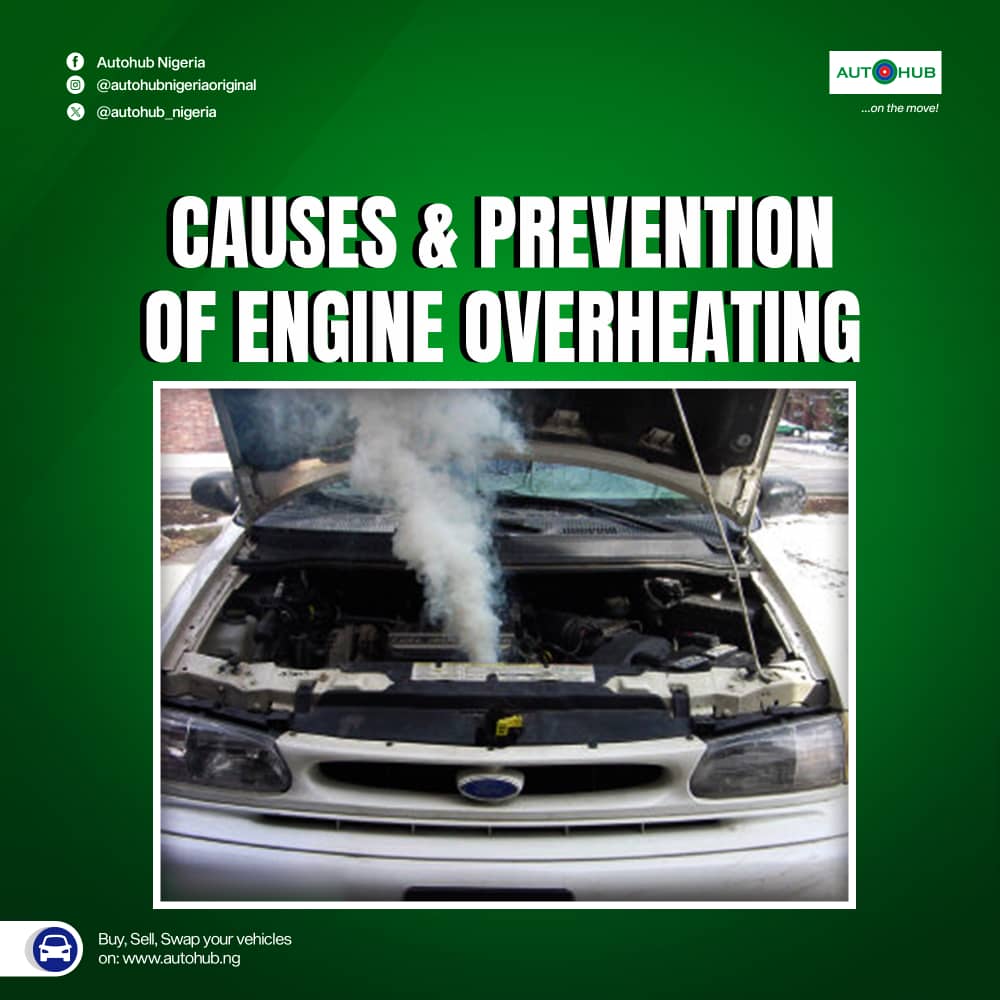
Engine overheating can and does happen; if proper precautions aren’t taken, the damage may be irreversible. An overheated engine can cause serious damage and ruin your ride. If you are in a vehicle that overheats, you need to stop driving and turn off the vehicle immediately.
Today’s engines are generally designed to last, but if a vehicle’s engine generates heat well above normal operating temperatures, the equipment used to cool the heat distribution can begin to fail, potentially causing permanent engine damage. There are steps that can be taken to evaluate the problem, but before you understand why your engine is overheating, it’s best to understand the role of the engine’s cooling system as the entire cooling system maintains the engine at standard operating temperature by circulating coolant through the engine to the radiator, thus removing heat from the engine.
There are many reasons why a vehicle’s engine can overheat, such as a leaking cooling system, clogged hoses due to corrosion and mineral deposits, radiator problems, or a faulty water pump. Regular checks can help avoid overheating problems in the future. Now you may ask what are the most common causes of engine overheating? There are many reasons why a vehicle’s engine can overheat, and in some instances it may be resolved via a quicker solution, such as topping up the coolant, but other times – the problem can be more complicated and will need to be properly addressed by a professional.
Below are common factors that can cause a car to overheat:
1. Too little or no coolant
Driving without properly gauging the levels of coolant may cause a coolant system failure. If coolant levels are lower than the manufacturer’s recommendation, refill or top it off to the levels required with new coolant. When adding new coolant to an empty reservoir use only a 50/50 mix of coolant and water. If you are unsure where the coolant reservoir tank is located or the proper method for refilling it, refer to your vehicle owner’s manual.
2. Cooling system leaks
An empty coolant reservoir tank could be caused by a potential leak. Leaks in the coolant can often be identified by spots or puddles on the ground.
Be aware that coolant will have a sweet smell and may be green, blue or orange in colour depending on the type of coolant being used.
3. A broken water pump
The water pump’s job is to circulate the coolant throughout the engine. If the coolant is dirty or has too much buildup, it can stop the coolant from moving through the pump, which can eventually lead to an overheating situation.
4. Radiator issues
Radiators and their fans help to reduce heat from the engine by decreasing coolant temperatures. Issues with the fans may reduce the capability of the radiator to remove heat, which in turn – will cause unnatural temperature increases. Pretty certain a few of us must have had the glorious opportunity to experience this first hand.
5. Oil too low
Outside of lubricating the engine’s parts, a vehicle’s motor oil helps control overall temperatures. Low oil levels may increase engine temperatures.
6. Thermostat failure
The thermostat in a vehicle is needed to regulate engine temperatures. A thermostat failure may cause harm to the engine by not allowing the coolant to flow as intended by the vehicle’s manufacturer.
7. Issues with the belts and hoses
If coolant hoses are leaking, blocked, ruptured or if the belts are worn out or frayed, their purpose of maintaining air and coolant flow to and from the engine and its related systems – will be drastically limited and may lead to unexpected engine damage.
8. Heater core is clogged up
Coolant flow may be compromised if the engine’s heat exchanger unit is clogged or blocked, which can cause overheating in a vehicle’s engine.
Signs and symptoms of overheating
Knowing the common causes of engine overheating will help you learn about the symptoms to enable you to take quick actions.
In most cases, the pressure caused by the excess heat can cause some incidents if the bonnet gets opened too quickly like smoke coming out or hot vapour that can scald one’s skin. It is better to let the engine cool for a while before opening up the bonnet. Some common symptoms of an overheating engine include:
1. Notice from the Temperature Light/Gauge
You would often notice the warning light or temperature gauge due to temperature changes. Whenever your vehicle starts exceeding the optimum temperature required for a smooth operation. You will see the temperature light coming on.
The red on the temperature gauge can also be visible If you don’t see the red indication, you may see the gauge towards the top. However, this sign may seem tricky to read, especially when there is a coolant leak.
2. “Tick” noise from the engine
Without the “thick” engine oil working through the car’s moving parts, it becomes pretty challenging for parts to move with less friction.
The oil is a good enough lubricant, but it loses its ability when the engine becomes super-heated. The heat makes the weight of the oil reduce drastically, making it appear too thin like water. Thus, all the lubricating capabilities get lost. With this, the clearances in the engine would start giving off a ticking sound.
3. Thumping sound
A thumping sound often results from a faulty thermostat, blocking the coolant flow to the radiator. Don’t get this wrong; the thermostat often blocks the coolant from flowing to the radiator in cold conditions, as an engine will not start when running cold.
When there’s a failure in allowing the coolant into the radiator, the coolant gets heated within the engine block. When this occurs, you will start hearing this thumping sound from the front area of the engine. It occurs in a bid of the cold coolant situated in the radiator trying to create a mixture with the heated coolant held back in the engine block.
4. Smoke emission from the bonnet
With the effect of extreme temperature, steam/smoke starts emitting from the car’s bonnet as the coolant starts boiling. In essence, the coolant is way past its boiling point and would start acting like steam water. This sign seems more pronounced, and with it; you can tell that your engine is overheating.
5. Coolant Spillage
Ever seen a car that has some spillage on the ground after parking for a while? Well, most Nigerians aren’t strangers to said spillage(s). Sometimes it may be fuel, water, oil spillages or a mixture of the aforementioned. Nevertheless, the coolant may also leak. You can notice such on the ground after leaving your car parked for a while.
Such spillage on the ground can be due to a leak from the cooling system, which would cause the engine to overheat. However, if the coolant has been boiling inside the cooling system, the car will find a way of relieving it through its coolant overflow tank.
What to do if your vehicle begins overheating
If you’re on the road and the dashboard warning lights come on, you notice a strange smell coming from the engine, or see smoke, or feel your car isn’t driving as it should, please follow these precautions:
1. Pull over and assess the situation
As soon as you notice an issue with your vehicle, the next course of action is to pull off the road to a safe position and clear area, then turn off the vehicle. If a vehicle is overheating, continuing to drive it may potentially cause irreversible engine damage.
2. Keep moving only if necessary
If there is a situation where you are not able to come to a complete stop in a safe and clear area, keeping the vehicle moving slowly (in some cases) may still allow constant airflow around the motor to help aid natural cooling. Leaving your car at rest with the engine running may worsen the problem, which can quickly produce additional and unwanted heat.
3. Open all the windows
The goal is to release as much heat as possible. Rolling down and opening as many windows as possible is another way to allow heat flow out from the vehicle.
4. Call for assistance
And finally, we saved the best for last as this is usually the first order of business – call for the service of your mechanic or roadside assistance.
Preventive measures to take in order to avoid overheating of the engine
Remembering a few quick tips as you drive can help to alleviate permanent engine damage. These are a few to be aware of:
1. Check your vehicle’s coolant levels on a consistent basis.
2. Store an extra bottle of coolant and a gallon of water in your boot.
3. Monitor your car’s thermostat as you’re driving.
4. Do not overuse the car’s air conditioning on extremely hot days especially if you notice the temperature gauge needle rising higher and higher within a short timeframe.
5. Help cool the engine by slowing down, then turning off the engine at the first sign of overheating.
6. Refer to the vehicle owner’s manual to stay up to date on coolant service flushes.
7. An overheating engine is a sign of a serious issue. Regular maintenance checks will help identify problems early on, before potentially causing permanent damage to your vehicle.
8. Do not try to open the bonnet/hood of your car until the vehicle has cooled down.
9. Once the vehicle is at a complete stop and turned off, do not lift the bonnet/hood immediately or you could risk serious scalding. Depending on how long the vehicle has been running, the coolant in the vehicle could be increasing in temperature to an extremely hot level, and essentially pressurising the cooling system itself!
Only when the vehicle has completely cooled down will it be suitable to attempt to open the bonnet/hood! The vehicle should be allowed to cool down naturally before opening, we can’t overemphasise the importance of this very action.
10. Again, be patient. Do take your time and ensure the vehicle has cooled down before attempting any form of repair. Don’t be a hurry if your car is overheating.
To confirm that the vehicle has appropriately cooled down, monitor the temperature gauge in your vehicle as it moves from hot to cool, which may take upwards of 30 minutes. Depending on the vehicle you drive, the temperature gauge may only be functional when the ignition is in the “accessory” or “on” position. During this step, it’s important to not start the engine, and in this situation, only activate the ignition to the “on” position to read the temperature gauge. To reiterate, DO NOT START THE ENGINE TO READ THE GAUGE. Only turn on the ignition. Thanks for reading. Wishing you a safe drive out there.











No Comments